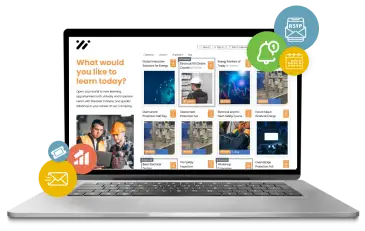
Top Blended Learning & Online Training Tools for 2025
As we step into the ever-evolving landscape of education and professional development, the demand for versatile and effective blended learning tools continues to soar. Whether you're a trainer seeking innovative online training tools to make your training programs more engaging or a business leader aiming to upskill your workforce, this blog post is your gateway to the top e-learning tools of 2025.
In this digital age, the right tools can unlock limitless opportunities for both learners and training providers. Facilitating seamless knowledge transfer and employee skill enhancement. Join us as we explore the best blended learning and online training tools for trainers that are shaping the way we learn and grow this year.

I. 10 Tools for Online Training and Blended Learning Courses:
Remember that the choice of virtual and blended learning technologies should align with your specific needs, budget, and technological infrastructure. It's also good practice to regularly assess and update your toolset to incorporate new features and technologies. Ones that can enhance your blended learning and online training programs.
Here are some of the top digital tools for blended learning and online training:
- Training Management Systems: Timely
- Video Conferencing and Webinar Tools: Zoom, Microsoft Teams, Cisco Webex, Adobe Connect, GoTo Meeting.
- Content Creation Technology: AI tools, Articulate 360, Adobe Captivate
- Collaboration and Communication Apps: Whiteboard apps
- Virtual Classroom and Webinar Platforms: BigBlueButton, Adobe Connect, WizIQ, ClickMeeting.
- Assessment and Quiz Tools: Kahoot!, Quizlet, Formative, Quizizz.
- Content Authoring Technology: Articulate Storyline, Adobe Animate, iSpring Suite, Lectora, Elucidat.
- Social Learning and Community Building Platforms: Padlet, Discourse, Facebook Groups, LinkedIn Learning
- Analytics and Reporting Tools: Timely, Google Analytics, Learning Locker, xAPI, Tableau, Power BI.
- E-books and E-learning Content Libraries: Amazon Kindle Direct Publishing, Coursera, Udemy, Skillshare.
1. Training Management Systems (TMS)
At the heart of effective online and blended training programs lies the Training Management System (TMS). A versatile platform that orchestrates the seamless convergence of in-person and online educational experiences. With intuitive interfaces and robust functionalities, a TMS becomes the nucleus of your in-person, online, hybrid and blended training courses. Further streamlining course promotion, scheduling and registration, content distribution, assignment management, and instructor-learner interactions.
A TMS serves as the central hub for your virtual and blended courses. Providing a platform to host content, manage assignments, and facilitate communication between instructors and learners. This digital ecosystem not only provides students with around-the-clock access to course materials, but also empowers trainers. Who can curate, organize, and present content in engaging ways.
Through its intuitive interface, a training management software fosters collaborative learning, enabling learners to connect, share insights, and seek assistance within the virtual learning environment. By embracing a TMS, training providers ensure a cohesive, user-friendly experience that caters to diverse learning styles and encourages active participation.
2. Video Conferencing and Webinar Online Training Tools
In the realm of online training and blended learning, video conferencing tools emerge as indispensable bridges between physical and virtual learning spaces. Virtual meeting platforms transcend geographical boundaries, offering live online sessions that replicate the dynamics of face-to-face interactions. The most prominent video conferencing tools for online training and blended learning are: Zoom, Microsoft Teams, Cisco Webex, Adobe Connect and GoTo Meeting.
Furthermore, real-time engagement nurtures meaningful discussions, enriching the learning experience by fostering dialogue, debate, and collaboration among both students and instructors. The flexibility of video conferencing accommodates varying schedules, allowing participants to engage with the course content regardless of their location. Whether facilitating interactive lectures, group discussions, or one-on-one mentoring, these online training tools promote an inclusive, dynamic, and engaging educational environment.

3. Content Creation and Management eLearning Tools
Elevating the art of instruction, content creation tools like Articulate 360 and Adobe Captivate empower instructors to craft immersive, interactive online materials. By integrating multimedia elements such as videos, presentations, and quizzes, these technologies transform traditional course content into dynamic learning experiences. Also, there are several AI tools that can aid in content creation.
Moreover, instructors can tailor content to resonate with diverse learning preferences, following learning pyramid strategies and catering to visual, auditory, and kinesthetic learners alike. This creative customization extends engagement and enhances comprehension, ensuring that learners remain captivated by the course materials. Furthermore, these tools for blended learning offer a fluid means of updating content. Therefore enabling instructors to seamlessly integrate real-time insights and industry developments, keeping the curriculum current and relevant.
4. Online Communication and Collaboration Apps
Effective communication forms the cornerstone of successful online training and blended learning programs. Leveraging the convenience of email, messaging apps, and discussion boards, communication tools facilitate direct interaction between instructors and students. Indeed, learners can share insights, seek clarification, and engage in dialogue outside of scheduled sessions, nurturing a sense of community and mutual support.
Additionally, online learning collaboration tools, such as whiteboard apps, can be very helpful to foster collaboration when delivering online and blended training courses. Therefore, enhancing engagement and ensuring that learners remain connected to their peers and trainers. With open lines of communication, learners can address queries, resolve challenges, and share perspectives, fostering a vibrant exchange of ideas that enriches the learning journey.

5. Virtual Classroom Tools for Blended Learning
Virtual classrooms bring a multitude of advantages to the educational landscape. One might ask if there is a palpable difference between virtual classrooms, mentioned above, and video conferencing tools. While both virtual classroom tools and video conferencing platforms enable remote communication, they serve different purposes.
Virtual classroom software is tailored for educators and trainers who need a structured, interactive, and engaging environment for online education. Meanwhile video conferencing platforms are more general-purpose tools for meetings and discussions in various professional contexts. The choice between the two depends on your specific needs and the type of interaction and engagement you require for your remote activities.
Training providers benefit from virtual classrooms, which provide live and immersive learning experiences, enhancing their capacity to deliver engaging and impactful education. Educators, too, find these platforms invaluable, as they can craft compelling, real-time learning environments.
Meanwhile, students reap the rewards, experiencing interactive, live sessions that afford them opportunities for real-time engagement and meaningful discussions, ultimately enriching their educational journey.
The leading platforms for virtual classrooms in the realm of online training and blended learning are: BigBlueButton, Adobe Connect, WizIQ, ClickMeeting.
6. Online Assessment and Quiz
In the pursuit of holistic learning, online assessment and quiz tools play a pivotal role. Since they aid in evaluating learners' progress and comprehension.
Training providers harness these blended learning tools to design quizzes, assignments, and exams that gauge learners' understanding and knowledge retention. The immediate feedback provided through these assessments not only guides learners' learning pathways but also reinforces their motivation to excel.
By offering insightful feedback and performance analysis, instructors ensure that learners remain on track. And they can address any gaps in their understanding promptly. Moreover, these assessment tools foster a growth mindset. Further enabling learners to continuously refine their skills and enhance their grasp of the course content.
The most prevalent options for assessment and quiz blended learning tools are: Kahoot!, Quizlet, Formative, Quizizz.
7. Content Authoring Tools for Blended Learning
Content authoring tools offer a host of advantages in the educational realm. Training providers can harness these tools to craft bespoke, interactive learning materials precisely tailored to their unique training requirements. Therefore, enabling a highly customized and effective approach to education. Educators, too, benefit as they wield content authoring tools to design captivating lessons and resources. Seamlessly integrating multimedia elements that elevate the overall learning experience, fostering engagement and comprehension.
Consequently, students are exposed to dynamic, multimedia-enriched content that caters to a wide spectrum of learning styles. This, in turn, promotes deeper engagement and a more comprehensive understanding of the subject at hand.
The most relevant content authoring eLearning solutions out there are: Articulate Storyline, Adobe Animate, iSpring Suite, Lectora, Elucidat.

8. Social Learning and Community Building
Social learning and community-building tools for blended learning offer a range of advantages across the educational landscape.
Moreover, training providers benefit as these tools cultivate a strong sense of community among learners. Therefore, resulting in increased engagement and improved retention rates. On the other hand, educators can leverage these technologies to establish collaborative learning environments. Ones where students have the opportunity to engage in discussions, exchange insights, and learn from their peers. Furthermore, fostering a dynamic and interactive educational atmosphere.
Meanwhile, students themselves benefit significantly, as they can connect with fellow learners, share knowledge, and actively participate in discussions. Consequently, these tools for online training enhance students’ overall learning experience through increased interaction and collaboration.
Some great community building blended learning tools are: Padlet (for collaborative boards), Discourse (for online forums), Facebook Groups (private groups for discussions), LinkedIn Learning (for professional networking).
9. Analytics and Reporting Tools for Online Training
In the data-driven landscape of online training and blended learning, analytics and reporting tools provide instructors with valuable insights. Diving into learners' engagement and performance. By capturing metrics such as participation rates, completion rates, and assessment scores, these tools equip educators with the information needed to make informed instructional decisions.
Also, training providers can identify trends, assess the effectiveness of various teaching strategies, and tailor their approach to optimize learning outcomes. With data-driven insights, educators can cultivate a proactive approach to teaching. Addressing challenges promptly and enhancing the course experience based on evidence-backed adjustments.
This iterative process ensures that each iteration of the course is more refined and impactful than the last. Timely training management platform offers analytics and reporting features so you can obtain comprehensive reports and data, including course awareness, engagement, registration and attendance. Empowering you to analyze and make informed decisions regarding your next steps and strategies for improvement.
Other important additional tools for analytics and reporting are: Google Analytics, Learning Locker, xAPI (Experience API), Tableau (for data visualization) and Power BI.

10. E-books and E-learning Content Libraries
E-books and e-learning content libraries offer a range of benefits across the educational spectrum.
For training providers, these resources serve as valuable supplements to course offerings. Streamlining the curriculum development process and conserving both time and resources. Educators can seamlessly integrate e-books and library resources into their courses. Therefore enriching the learning experience with a diverse array of materials.
Meanwhile, students reap the rewards of this accessibility, enjoying an extensive pool of supplementary materials. Ones that bolster their comprehension and research capabilities, ultimately enhancing their educational journey.
These are great online training tools for e-books and content libraries: Amazon Kindle Direct Publishing, Coursera, Udemy, Skillshare.
II. Essential Software for Launching Online Training and Blended Courses:
In the dynamic landscape of education, training providers and organizations are increasingly turning to software solutions to enhance the delivery of their courses. With the rise of online and blended learning models, the need for versatile software has become paramount. Such software streamlines content management, facilitates real-time communication, and offers interactive tools to engage learners.
Training Management Systems (TMS), such as Timely LMS for Training, are central in this approach. Acting as repositories for course materials, assessment platforms, and communication hubs. Video conferencing tools enable seamless virtual sessions, while content creation software empowers instructors to craft engaging multimedia materials. Furthermore, assessment tools, analytics software, and collaborative platforms ensure a holistic learning experience.
As training providers embrace technology-driven education, the right software becomes the backbone of effective online and blended learning. Further enriching both instructors' teaching capabilities and learners' educational journey.

III. FAQs on Online Training & Blended Learning Tools
1. How can I choose the right e learning software and tools for my specific needs?
Selecting the appropriate tools for virtual learning should align with your particular requirements, budget, and technological setup. Careful consideration of factors such as the nature of your courses, target audience, and desired learning outcomes will guide you in making informed choices.
Timely training management software, for example, is a great option for those seeking a versatile online training tool. With integrated white-label and custom design options, automatized email marketing and social media promotion. Timely online training software allows you to effortlessly craft, publish, and market your courses and programs, all within a unified online training platform. Moreover, Timely training scheduling software is a rich tool that handles online registrations, streamlines secure payments, and ensures your courses thrive also offering comprehensive analytics.
2. Why are Training Management Systems (TMS) considered essential for blended and online training courses?
LMS for Training acts as the central hub for online and blended courses. Offering features for course promotion and registration, content distribution, assignment management, and instructor-learner interactions.
Moreover, these online training tools provide a cohesive, user-friendly experience. Also ensuring that learners have access to course materials around the clock and empowering instructors to create engaging content.
3. How do video conferencing eLearning tools enhance blended learning?
Video conferencing tools bridge the gap between physical and virtual learning spaces, allowing for live, interactive sessions. They promote engagement, meaningful discussions, and collaboration among students and instructors. Therefore enabling a dynamic educational environment that accommodates various schedules and locations. Therefore, they are considered as one the best online training tools.
4. What role do analytics and reporting tools play in online and blended courses?
Analytics and reporting are great digital tools for blended learning because they provide valuable insights into learners' engagement and performance. Indeed, they help instructors identify trends, assess teaching strategies, and make evidence-based adjustments to optimize learning outcomes. These online training tools foster a proactive approach to teaching, ensuring continual improvement in course quality.
Table of Contents

Event Management Updates
If you want to know more Timely company and product update news, please visit our Event Management Blog. There is always something new happening at Timely, so we do our best to keep our clients on the loop!
You might also like






